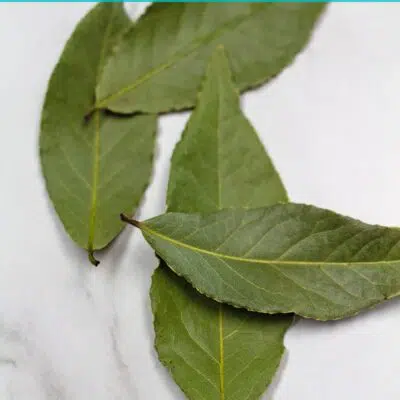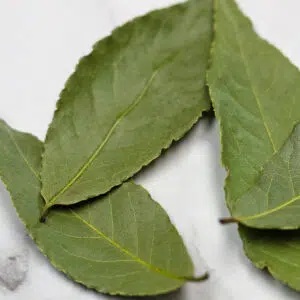All of my best bay leaf substitute options are shared here for those moments when you go to start a recipe and realize you've run out, or simply don't keep bay leaves on hand! Whether you're making hearty sauces, soups, stews, chili, or roasts, the flavor of bay leaves is a common component!

Everything you need for swapping out bay leaf flavor in a flash!
The debate is still out about whether or not the inclusion of a bay leaf adds superior depth of flavor to a hearty dish. However, I'm a firm believer in the excellence of bay leaves!
So while you could simply omit the bay leaf and move forward with your recipe, I thought you'd like to know all of the wonderful alternatives for bay leaves that are available!
Table of contents
What are Bay Leaves?
Bay leaves are the leaves of the Laurel tree, native to warm climates, like the Mediterranean. Often used in cooking, bay leaves can be used fresh, dried, crushed, whole, or ground to give flavor to soups, stews, sauces, broths, meat dishes, and more.
The flavor resembles spearmint and menthol, pine, and black pepper. Fresh bay leaves also have floral notes in flavor and can be found (sometimes) at the grocery store. *Check the herb section in the produce aisles of your local stores.
However, fresh bay leaves are typically more expensive than their dried counterpart and don’t last nearly as long. So ultimately, dried bay leaves are the recommended choice.
Bay Leaves vs. Sage
Bay leaf and sage might look alike in shape and size, but they are entirely different herbs. Bay leaves are best used in soups, stews, sauces, and beans.
Sage is best used when making stuffing, poultry, pork, pasta, potatoes, with onions and walnuts, or paired with cheese.
Bay Leaf Substitutes
Depending on what your recipe calls for, note that one fresh bay leaf is equivalent to two dried bay leaves, one dried bay leaf is equal to ¼ teaspoon crushed bay leaf, and one fresh bay leaf is equal to ½ teaspoon crushed bay leaf.
1. Thyme
Despite the difference in appearance, thyme can be used as an alternative to bay leaf.
They both have a minty flavor, so go ahead and start with ¼ teaspoon of dried thyme when substituting one for the other (add more if you don’t think the flavor is strong enough).
2. Oregano
Another great alternative for bay leaf, oregano will add robust flavor to your recipe, as it is known for its earthy, slightly bitter, bold, sweet, and spicy flavor.
Fresh oregano can even be considered peppery, just like a bay leaf. A little goes a long way, so substitution amounts depend upon how much you love this strong herb, but as a general rule of thumb, use ¼ teaspoon of dried oregano for every 1 bay leaf the recipe calls for.
3. Mexican Oregano
Mexican oregano is a type of oregano, different than the traditional Italian or Mediterranean oregano that is commonly thought of. While regular oregano has minty undertones, Mexican oregano has citrus undertones.
This substitution would work well for chili, salsas, beans, and meat dishes that are being cooked in a Latin or Mexican style.
Use ¼ teaspoon in place of 1 bay leaf.
4. Basil
Basil can be used as an alternative for bay leaves, especially if the recipe that you’re making is Italian in origin, like tomato-based dishes and beef, because it has a sweet flavor.
Typically, basil isn’t recommended for other recipes, as it might change the flavor too much.
If you use basil in place of bay leaf, use a 1:1 ratio. Note that 4-8 fresh basil leaves equal 1 teaspoon of dried basil.
5. Boldo Leaves
Boldo leaves are commonly used in South American cooking and are related to the bay leaf. If you can find boldo leaves, use half of the amount, compared to bay leaves. For example, if your recipe calls for two bay leaves, use one boldo leaf.
The flavor of boldo leaves is similar to bay leaves, but are known to be strong and potentially overpowering if used in the wrong quantity.
6. Juniper Berries
If you have no pregnant women or young children who are advised not to consume juniper berries, you might consider using them in place of bay leaf, using ¼ teaspoon per bay leaf that the recipe calls for.
They have a similar flavor to bay leaves, leaving a slightly piney, fruity, peppery flavor. *Another note: Juniper berries pair really well with rosemary!
7. Rosemary
Rosemary’s flavor isn’t quite like that of the bay leaf, but it is a common herb used for culinary purposes due to its robust flavor.
It’s versatile and can be used as a bay leaf substitute with steaks, roasts, fish, lamb or mutton, goat, pork, and other gamey meats.
Use a 1:1 ratio and add more if desired.
8. Red Bay Leaves
Not necessarily a common pantry item, red bay leaves come from the red cove plant, a type of evergreen tree. The leaves aren’t actually red (they're still green) and look like bay leaves.
Use it for seasoning dishes, just like you’d use a bay leaf.
Best Substitutions for Specific Recipes
For Indian Recipes
The leaf commonly seen in Indian recipes isn’t actually the laurel bay leaf that we know and love. It’s entirely different. The Indian Bay Leaf, also known as Teja Patta, comes from the cassia tree and tastes more like cinnamon.
It is not recommended to use the laurel bay leaf in Indian cooking, and instead, substitute with cassia, cinnamon, or clove if you don’t have an Indian bay leaf.
For Soups and Stews
For soups and stews, it is recommended that you use thyme, oregano, or boldo leaves as bay leaf substitutes. Any of these herbs will result in a beautifully flavored final dish without ruining the integrity of the recipe.
Recipes Using Bay Leaves
Some of my favorite recipes that use bay leaves range from my much better than store-bought corned beef seasoning mix, to soups and stews like sopa de chicharos, green chile chicken stew, and my prime rib soup. Use your bay leaves in hearty mains like chicken mandi and turkey carnitas, or deepen the amazing flavor of the French classic, beef bourguignon!
More Great Substitutes!
FAQ
Yes! While there is doubt surrounding the importance of the bay leaf and you probably wouldn’t notice if it were missing, bay leaves do add a nice herbal flavor to slow-cooked sauces, soups, stews, rice dishes, and more.
It isn’t recommended to eat a bay leaf, so if you are extra curious and want to know what they taste like, simmer some in a pot of water and give it a try!
As mentioned above, bay leaves add a minty, piney, black pepper flavor that can be slightly bitter, yet slightly floral.
Yes, definitely! If you do substitute basil for bay leaf, it is recommended that you use dried basil, as the flavor will better match that of a bay leaf.
Basil, a member of the mint family, tastes bitter, peppery, and has hints of licorice anise. When dried, basil loses its anise flavor and becomes more like a bay leaf.
Oregano or thyme (in general) are the best substitutes for bay leaves. Read above for more substitutes to fit what you have available to you and/or to best suit your recipe.
📖 Recipe Card
Bay Leaf Substitute
Ingredients
Option 1 - Dried Thyme
- ¼ teaspoon dried thyme
Option 2 - Dried Oregano
- ¼ teaspoon dried oregano
Option 3 - Dried Mexican Oregano
- ¼ teaspoon dried Mexican oregano
Option 4 - Fresh Basil
- 1 leaf fresh basil *Best used in Italian recipes.
Option 5 - Boldo Leaves
- 1 leaf Boldo leaves *For each 2 bay leaves.
Option 6 - Juniper Berries
- ¼ teaspoon Juniper berries
Option 7 - Rosemary
- 1 stalk rosemary
Option 8 - Red Bay Leaves
- 1 leaf red bay leaves
(Note: 2x or 3x only changes the ingredient list)
Instructions
Option 1 - Dried Thyme
- Use ¼ teaspoon of dried thyme per each bay leaf called for in a recipe.
Option 2 - Dried Oregano
- Use ¼ teaspoon of dried oregano per each bay leaf called for in a recipe.
Option 3 - Dried Mexican Oregano
- Use ¼ teaspoon of dried Mexican oregano per each bay leaf called for in a recipe.
Option 4 - Fresh Basil
- Use 1 fresh basil leaf for each 1 bay leaf called for in Italian-inspired recipes. Note that 4-8 fresh basil leaves equal 1 teaspoon of dried basil.
Option 5 - Boldo Leaves
- Use 1 Boldo leaf per each 2 bay leaves called for in a recipe.
Option 6 - Juniper Berries
- Use ¼ teaspoon juniper berries per each bay leaf called for in a recipe. *NOTE that it is important to avoid cooking with juniper berries if pregnant women or children will be eating the meal.
Option 7 - Rosemary
- Use in a 1:1 ratio, 1 rosemary sprig per each bay leaf called for in a recipe.
Option 8 - Red Bay Leaves
- Use in a 1:1 ratio, 1 red bay leaf per each bay leaf called for in a recipe.
For Indian Recipes (Indian Bay Leaf)
- Do not use the common bay leaf in Indian recipes. Instead, to substitute for the Indian bay leaf, use cinnamon, cloves, or cassia.
For Soups & Stews
- The best herbs to substitute for bay leaves when making soups and stews are oregano, thyme, and boldo leaves.



Comments
No Comments